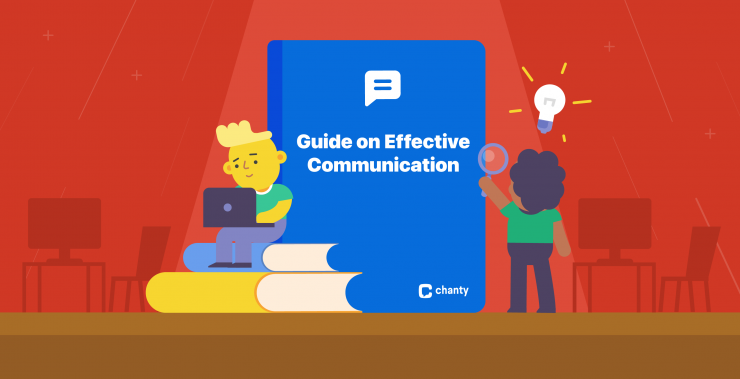Failure to meet deadlines, long email threads, disputes during meetings, poorly planned projects, missing files, delayed feedback, you name it. How about meetings where people are talking to each other and thinking they are discussing the same thing, but it is obvious that they don’t?
Rings a bell? Of course, it does. We’ve all been there.
Team communication isn’t always as effective as we’d want it to be, and it has a direct impact on every area of an organization. It has an impact on team dynamics, how people collaborate, leadership communication, and so much more. Communication may make a difficult task easy, but it can also make a simple task impossible.
Effective communication often depends on a clear understanding of effective communication guidelines, a framework that helps overcome common workplace obstacles. Knowing what to say, how to say it and when to listen is essential to fostering a positive, productive working environment and building healthy communication across teams.
Ineffective communication has long been one of the top problems in any organization. When communication breaks down, it can derail even the most meticulously planned projects, leading to a ripple effect of misunderstandings and unmet objectives. Miscommunication isn’t always about what is said; sometimes, it’s about what isn’t said or conveyed ineffectively. It’s vital to focus on steps for effective communication that can transform interactions from chaotic and confusing to coherent and productive.
What skills do we need to have effective team communication? And what can be done to encourage good communication?
We created this comprehensive guide for effective communication to help us improve our workplace. We’ll go through what successful communication looks like, the benefits it provides, and how we may implement it in our workplace.
With the right strategies, we can create a robust communication framework that not only increases productivity but also strengthens team relationships and fosters an atmosphere where ideas can be openly shared and solutions efficiently arrived at.
What Is Effective Communication?
On a daily basis, everyone communicates. In its basic form, communication is simply talking to another person, a means of conveying information and instructions. Sure it is important in everyday life since it allows us to create deeper connections with those around us, but is that all? Just words?
Not exactly…
Communication encompasses a wide range of different elements of non-verbal communication including voice tone, body language, and eye contact. You might believe you’re a great communicator because you talk a lot during the day, but there’s a difference between someone who talks a lot and someone who truly understands how to communicate better annd does it successfully.
Effective communication should be a dialogue rather than a one-sided lecture. A discussion allows everyone concerned to convey and gather vital information in an open and honest manner so that a final, well-informed decision can be made.
This involves active listening, where participants understand the speaker’s perspective, ask clarifying questions and provide thoughtful feedback.
It also requires you to tailor your message to your audience. What works in casual conversations may not be effective in formal meetings or written communications. Skilled communicators adjust their tone and language to suit the situation, ensuring that the message comes across clearly.
Timing and context are also important. A well-timed message, whether it is feedback immediately after a task has been completed or addressing concerns at the right moment, increases understanding and impact.
In summary, effective communication is about more than just talking – it is about ensuring that messages are clear, timely and understood, that feedback is valued and that all parties feel heard. This balance of clarity and empathy is what creates truly healthy communication in any workplace.
The Seven “C” of Effective Communication
The seven “C” of communication are a set of guidelines for ensuring that written and oral communications are effective. The seven Cs encompass clarity, correctness, conciseness, courtesy, concreteness, consideration, and completeness.
Clarity
The messages should be clear so that the reader doesn’t have to scratch their head to figure out what you’re talking about and make their own assumptions. If this happens, you’ll waste time on emails going back and forward. Do not try to convey too much information in a single message. Otherwise, the reader’s attention will be diluted. Make sure you know what you want to achieve or why you’re doing it. Sentences should be short, written in active voice, and try using bullet points.
Correctness
When there are too many emails to write in a day, people tend to type quickly and make spelling mistakes. If the incorrectly spelled term is actually another word in the English language, spell check will not be able to detect it. Ensure that you address them properly and correctly spell their names. Furthermore, you must guarantee that the reader has the necessary expertise and education to comprehend the technical phrases you use in communication.
Conciseness
People frequently write two sentences in places where they might have completed the message in just one. This wastes everyone’s time and, as a result, it has an effect on productivity. Avoid using fillers like “sort of,’ ‘I mean’, ‘essentially,’ ‘for example’, and so on. Try to convey a precise message.
Courtesy
In business, being courteous is quite important. People who work together are not necessarily friends, therefore being courteous is essential for maintaining a strong working relationship. Hidden insults and harsh tones could be troubling for individuals, which might result in lower morale and productivity.
Make an effort to be respectful, honest, pleasant, and open in your conversation. If you say it carefully, it will be really impactful and significant. People can be turned off by the offensive language.
Concreteness
You must believe in yourself and the message you wish to express to the audience. Your audience will have a clear picture of what you’re trying to tell them if the message you’re delivering is concrete. It will only be tangible if it is backed up by appropriate data. Your argument should be backed up by data and figures, leaving no room for the audience to conjure up their own scenarios.
Consideration
Stepping into the shoes of others. The audience’s background, viewpoints, education level, mindset, and other factors must be considered while communicating effectively. Make an effort to picture your target audience, their emotions, issues, and needs. Modify your message to meet the needs of the audience while yet remaining complete.
Completeness
Never leave a sentence unfinished. End each message on a sensible note. People shouldn’t be left in the dark about whether or not there is more to come.
Ask yourself these questions to make sure that your message is complete:
- Is there a “call to action” that lets your audience know exactly what you want them to do?
- Have you included all information, such as contact names, dates, times, and locations?
The шmportance of communication skills in teamwork
Team communication is critical if we want businesses to run like clockwork. Employees who can communicate up and down a company’s communication chain will have higher morale, commitment, and productivity. On the other hand, employers who invest time and effort in establishing open channels of synchronous communication can quickly build employees’ trust, which will increase performance and productivity.
Effective team communication fosters a positive corporate culture and promotes the transparency that is essential to maintaining a motivated and engaged workforce. When employees feel informed and valued through clear communication, they are more likely to commit to the company’s goals and feel more connected to the team. This trust and clarity can also minimize misunderstandings and conflicts, ensuring smoother collaboration across departments and hierarchical levels.
Being able to communicate effectively in the workplace could do a lot more, such as:
- Boost motivation
- Improve staff and client connections
- Increase job satisfaction
- Create a positive work environment
- Increase diversity
Ultimately, effective communication drives business success by aligning team members, increasing productivity and improving relationships both internally and externally. It’s not just about sharing information – it’s about creating an environment where everyone feels heard, respected, and empowered to contribute to the organization’s goals. This is the essence of healthy communication.
Tips to improve team communication
Communication abilities can be enhanced and learned through practice. They require time and experience to develop. Barriers to successful communication can arise at any point during the communication process, resulting in misunderstanding and confusion. Here are some pointers to help you overcome the hurdles and learn how to communicate better:
- Use communication tools
Apps and cloud-based communication software were created with one goal in mind: to make exchanging information easier for you and the team. Don’t be afraid to establish lines of contact that will make your life easier.
To improve communication, you could, for example, include any of the following communication tools in your everyday work activities:
- Chanty – Our own collaboration platform. You can download the app on your desktop or mobile device and connect it with other tools such as Zoom or Microsoft Office among others.
- Zoom — Zoom is a cloud-based video communications tool for conferencing and video meetings. It’s ideal for remote teams or staff that don’t work in the same offices.
- Smartsheet — The software allows businesses to track projects and tasks using a variety of sheets. Depending on your preferences, you can organize your sheets in Gantt, calendar, or grid.
- Microsoft Office 365 — This Office suite includes Microsoft Word, OneNote, Outlook, Excel, and PowerPoint. You and your team can collaborate on online versions of your spreadsheets or documents from different locations by using the platform.
- Vonage – This cloud communications provider offers various business communications tools that are ideal for hybrid and remote teams. Going beyond standard video conferencing, tools include a hosted phone service, messages API, and app-based communications.
- Create a safe atmosphere
If you want to have successful team communication, provide a secure environment for dialogue.
When an unsafe action occurs, we should address it. Avoidance will only heighten the sense of insecurity. Instead, try stepping out of the conversation when you notice violence, make it safe, and then return.
Honesty should be established early in the conversation. We’ll be able to have more open and successful dialogues if people feel confident speaking their thoughts without fear of being punished.
The truth, and nothing but the truth. When we sugarcoat the truth or distort the reality in any other way, we cannot have a productive dialogue. Be as genuine as possible. Be open with people. Even if they don’t have all the answers, they’ll appreciate your openness and will be more supportive.
It’s also important to respect confidentiality when discussing sensitive issues. Create an atmosphere where confidentiality is respected so that people feel safe to share their thoughts. This trust can make a huge difference in the openness of future interactions.
- Talk to the team constantly
Regular catch-ups with the team are a must. The more opportunities you give the team to communicate information and progress with you, the fewer challenges their performance will encounter.
For better results, we suggest using a setup like this:
- Team Meetings as a check-in with the team to see how things are and what they have planned. This could be a daily or a weekly call.
- One-on-ones as a time for you and your team member to discuss how the work is going. Regardless of how you structure these sessions, the crucial thing is that you give yourself time to chat without being interrupted.
- Town Hall Meetings are usually held on a monthly basis. This is the time when we can share the accomplishments of the company and give suggestions on how to improve productivity. These sessions are an excellent opportunity to ensure that the teams are aligned across the company.
In addition, asynchronous communication methods such as email updates or team dashboards can help share information with team members who may not be available for every live meeting, keeping everyone in the loop efficiently.
- Conduct team-building activities
Team building activities have a significant impact on the team’s productivity and general teamwork. They can help employees communicate more effectively and form positive relationships with one another. Not only do they improve their communication abilities, but also create trust and develop positive connections with one another. Icebreaker games, team lunches, fitness sessions, group meetings, outdoor activities, or puzzle-solving games, are just a few activities that could get a new group off to a fantastic start, or help an existing team tackle challenges that are preventing them from reaching their full potential.
Consider organizing workshops or retreats on conflict resolution and communication strategies. These events can provide structured opportunities for team members to learn and practice communication skills in a fun and engaging environment.
- Participate in training programs
New employee training should include specifics about their job role as well as information about the organization. This covers the company’s history, clients, and any internal standards about holidays and working hours.
Effective team communication skills should also be taught to the existing teams, as part of their work.
Programs intended for effective communication allow business groups to not only improve their oral communication communication abilities but also:
- Improve the impact of their presentations
- Learn how to read nonverbal cues
- Communicate during conflicts
Additionally, encourage employees to attend industry-specific workshops or webinars that focus on communication trends and innovations. Such sessions can help them keep up to date and bring useful techniques back to the team.
- Seek and encourage feedback
It’s crucial that employees feel at ease discussing their questions and concerns. The company’s communication flow should be a conversation rather than a monologue. When leaders provide feedback, they frequently make the mistake of turning it into a one-way conversation. Employees are not given the opportunity to express their own concerns. Encouraging two-way feedback is a hallmark of strong team communication. Take criticism and use it to improve.
Also, make sure you have regular feedback sessions where people know their opinions are valued. Tools such as anonymous feedback forms can be useful for getting honest input from those who may be reluctant to speak openly.
Start Communicating Better
Communication is essential to the success of our professional and personal relationships. It’s how we show that we care and how we get things done. That alone is motivation enough to improve our communication skills. Fortunately, we can all improve.
Effective communication can transform a workplace by fostering collaboration, reducing misunderstandings, and increasing productivity. Teams that communicate well are more engaged and motivated, which in turn drives innovation and growth. Leaders who encourage open and honest dialogue can create a culture of transparency where every team member feels heard and valued.
Remember that improving team communication begins with developing new effective habits. To have strong conversations, we need to improve our skills.
There are a plethora of ways to communicate effectively in our workplace, and it’s up to us to figure out which one is the best fit. Using modern tools such as communication platforms and training programs can speed up this process and make a noticeable difference in the way teams work. Whether through structured meetings or informal chats, each method can contribute to smoother workflows and better relationships.
It’s worth taking the time to get it right because trust me, the office will become a much happier and more pleasant place to work in. By prioritizing effective communication, you can not only improve your team’s performance but also foster a sense of belonging and trust. This shift can create a work environment where collaboration thrives, leading to long-term success for both individuals and the organization as a whole.










Add comment